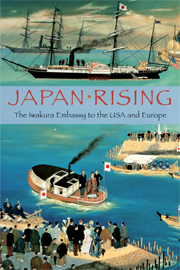Book contents
- Frontmatter
- Contents
- Introduction by Ian Nish
- Note on the Text
- VOLUME I THE UNITED STATES OF AMERICA
- VOLUME II BRITAIN
- VOLUME III CONTINENTAL EUROPE, 1
- VOLUME IV CONTINENTAL EUROPE, 2
- VOLUME V CONTINENTAL EUROPE, 3; AND THE VOYAGE HOME
- 82 The Vienna Universal Exposition, 1
- 83 The Vienna Universal Exposition, 2
- 84 A Record of Switzerland
- 85 Switzerland's Mountain Scenery
- 86 A Record of Berne and Geneva
- 87 A Record of Lyons and Marseilles
- 88 Spain and Portugal
- 89 Political Practices and Customs in Europe
- 90 European Geography and Transportation
- 91 The Climate and Agriculture of Europe
- 92 European Industry
- 93 European Commercial Enterprise
- 94 The Voyage Through the Mediterranean
- 95 The Voyage Through the Red Sea
- 96 The Voyage Through the Arabian Sea
- 97 A Record of the Island of Ceylon
- 98 The Voyage Through the Bay of Bengal
- 99 The Voyage Through the China Sea
- 100 A Record of Hong Kong and Shanghai
- Index
95 - The Voyage Through the Red Sea
Published online by Cambridge University Press: 04 August 2010
- Frontmatter
- Contents
- Introduction by Ian Nish
- Note on the Text
- VOLUME I THE UNITED STATES OF AMERICA
- VOLUME II BRITAIN
- VOLUME III CONTINENTAL EUROPE, 1
- VOLUME IV CONTINENTAL EUROPE, 2
- VOLUME V CONTINENTAL EUROPE, 3; AND THE VOYAGE HOME
- 82 The Vienna Universal Exposition, 1
- 83 The Vienna Universal Exposition, 2
- 84 A Record of Switzerland
- 85 Switzerland's Mountain Scenery
- 86 A Record of Berne and Geneva
- 87 A Record of Lyons and Marseilles
- 88 Spain and Portugal
- 89 Political Practices and Customs in Europe
- 90 European Geography and Transportation
- 91 The Climate and Agriculture of Europe
- 92 European Industry
- 93 European Commercial Enterprise
- 94 The Voyage Through the Mediterranean
- 95 The Voyage Through the Red Sea
- 96 The Voyage Through the Arabian Sea
- 97 A Record of the Island of Ceylon
- 98 The Voyage Through the Bay of Bengal
- 99 The Voyage Through the China Sea
- 100 A Record of Hong Kong and Shanghai
- Index
Summary
July 27th, 1873. Beautifully clear; not a cloud in sight.
At half past four in the morning we weighed anchor and set sail. We passed through three [four] lakes: Lake Menzala, [Lake Ballah], Lake Timsah, and the Bitter Lakes. At half past four in the afternoon we reached the port of Suez, where we dropped anchor for a while. We had covered eighty miles. At eight o'clock we left the harbour and put out into the Gulf of Suez.
It is only four years since it became possible to travel by ship from Port Said to Suez through the Isthmus of Suez. For this we must thank the French engineer [Ferdinand] de Lesseps. The construction of a great canal through this neck of land a hundred miles wide was the fruit of long years of dedication on his part. It was an immense undertaking. This hundred-mile stretch of land blocked communications between the Mediterranean Sea and the Red Sea and hindered trade among the continents of Europe, Asia and Africa. For thousands of years people had either to brave the stormy seas off the Cape of Good Hope or cross the red desert and dusty yellow wastes of Egypt on foot. The plan to make communications more convenient by removing this obstacle severely tested human knowledge and endurance.
- Type
- Chapter
- Information
- Japan RisingThe Iwakura Embassy to the USA and Europe, pp. 493 - 497Publisher: Cambridge University PressPrint publication year: 2009



